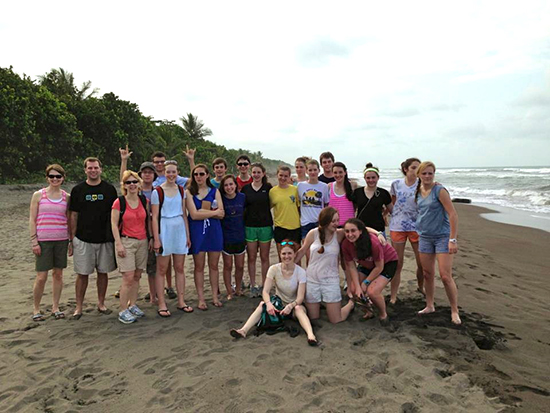By JP Riedel, Student at Dover-Sherborn High School, Dover, Massachusetts
Among Costa Rica's incredibly diverse range of creatures is the sea turtle. Costa Rica is home to several sea turtles including the Leatherback, Green, Hawksbill, and Loggerhead turtles. All of these wonderfully unique exotic creatures are important to not just Costa Rica's coastal environment but marine environments around the world as they migrate between oceans and continents. Unfortunately they are all either endangered or extremely threatened. The threats range from Illegal hunting, to pollution and climate change, and even fisheries and coastal development.

So how do we help the sea turtle? Well it is quite a difficult task.
Sea turtles spend one percent of their lives on land and it is hard to monitor them at sea, so scientists and volunteers have to make the most of the time that they have with the turtles on land. This often involves attaching a satellite transmitter to the shell of a sea turtle and tagging it so that they can record the turtle's migration patterns. Volunteers also film and record female sea turtles at night while they lay their eggs. A group of high school students touring Costa Rica as part of EF's Global Student Leaders Summit recently had the opportunity to see some of these precious turtles during an evening beach walk in Tortugero, Costa Rica.

We learned that the amount of eggs that each sea turtle can lay in a nest varies between species but ranges from eighty eggs to two hundred eggs in each nest and ranges from six nests a season to ten times a season. With the amount of eggs being laid you would think that there should be an overpopulation of sea turtles. The sad truth is that very few baby turtles make it to the ocean due to poachers and dogs looking for the eggs to eat, and the ones that do make it have to swim out into the ocean and avoid predators such as sharks or even just bigger fish.
What we also learned was that the development of coastal resorts and businesses have infringed upon the sea turtle's habitat, destroying nesting grounds. This is something that we in America face all the time. Fortunately governments, such as Costa Rican's, have begun to take notice and aid in increasing sea turtle populations thanks to major contributions from scientists around the world.
The first person to bring attention to the plight of the sea turtle was Dr. Archie Carr. In the 1950s and 60s, Dr. Carr traveled to South America to the island of Tortuguera. From there, he studied many different species of turtles and realized they were in harm of being over-hunted. He studied how the locals used the sea turtle as a main source of food and sold their shells to be made into jewelry. Turtle soup was a very popular commodity in the 1950s and so hunting sea turtles was a lucrative business. But since then, thanks to Dr. Carr, the mindset of many people has changed. People in Central American countries, such as Costa Rica, used to hunt turtles as part of their culture and income. Now, tourism dominates the market as people come from all around the world to catch a glimpse at these wonderful creatures and volunteer for organizations that "make waves" in the study and protection of sea turtles.

Today, one of the largest organizations working to save the sea turtle is the Sea Turtle Conservancy in Costa Rica. This organization was founded by Dr. Carr in 1959 and thanks to efforts from the conservancy, we now know more than ever about sea turtles. For example, the temperature of the sand surrounding sea turtle eggs determines the sex of the turtles, as opposed to X and Y chromosomes like humans. The hotter the sand, the more turtles will be female. We also know that turtles migrate for nesting every two to three years and travel hundreds of thousands of miles to lay their eggs. Furthermore, the largest known sea turtle, the Leatherback, can grow to be two meters in length and can weigh up to five hundred kilograms which is just over one ton.
The Sea Turtle Conservancy has made a great deal of effort over the years to ban the hunting and killing of sea turtles and raise awareness so that people will understand that we cannot afford to lose a creature as beautiful as the sea turtle. Our small planet is so rich and diverse in life that it would be a shame to let even one species slip into the night gone and forgotten forever.
All of us traveling to Costa Rica are excited to experience a new culture and share our ideas with students from around the world through EF's Summit! Follow us on Twitter at #EFSummit or on Facebook at www.Facebook.com/EFSummit.
About the Global Student Leaders Summit Series
This post is part of a series produced by The Huffington Post and EF Education First, in recognition of the 2013 EF Global Student Leaders Summit in Costa Rica (April 20 and 21). Each year, the EF Global Student Leaders Summit brings together hundreds of high school students and teachers from around the world for experiential learning tours and a leadership and innovation conference to help the next generation of leaders understand and solve critical global issues. For more information on EF Education First, click here.
